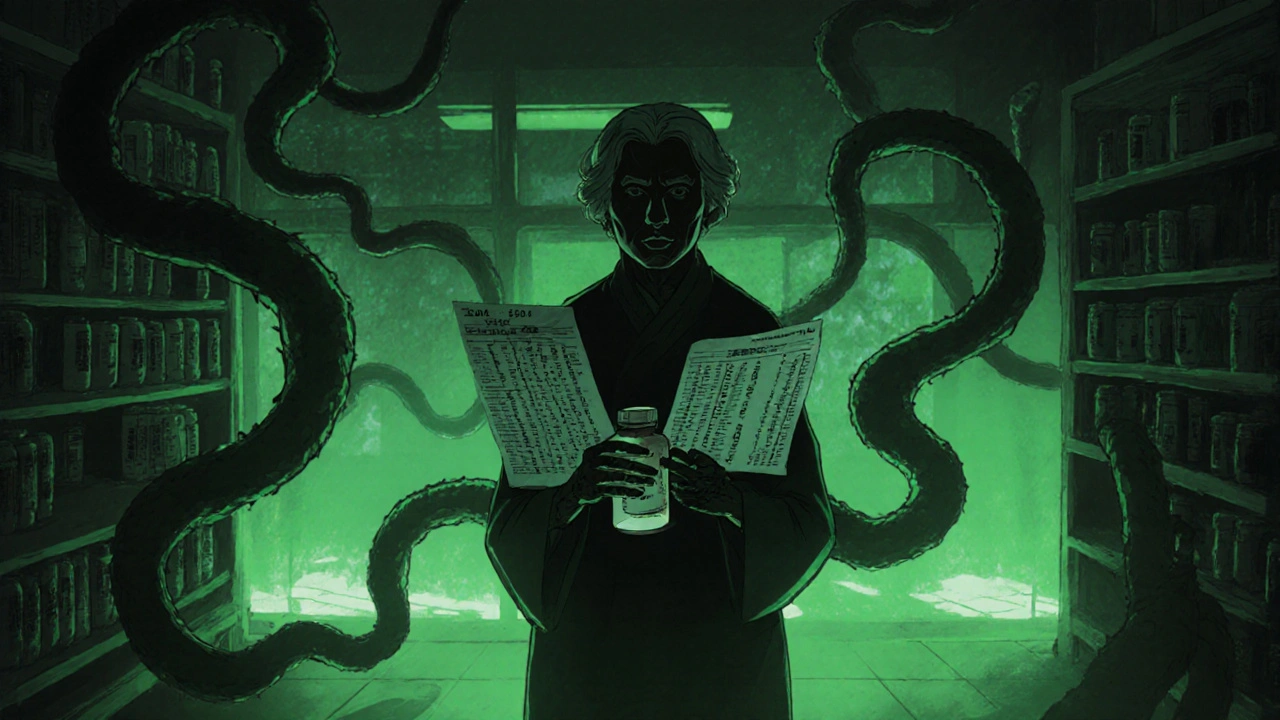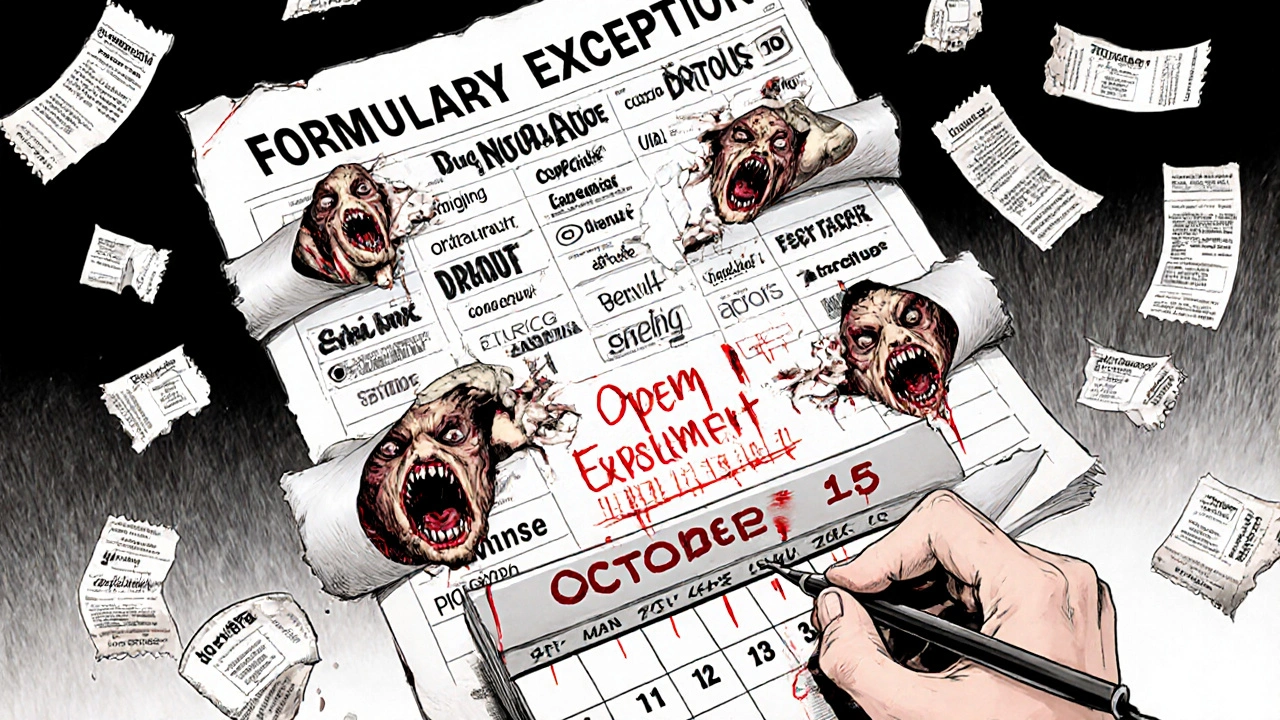
When you’re on Medicare Part D, your prescription drug coverage isn’t just about which pills are covered-it’s about what you can swap them for when your usual medicine isn’t available, gets too expensive, or gets moved on your plan’s list. This is called substitution, and it’s not the same everywhere. One pharmacy might give you a generic version without asking. Another might refuse unless your doctor approves it. And if your plan changes its formulary next month, your current drug could suddenly be off-limits-no warning.
What Medicare Part D Substitution Actually Means
Substitution in Medicare Part D doesn’t mean you can walk into any pharmacy and trade your brand-name drug for any other drug you want. It’s a system built around formularies-lists of drugs your plan covers, grouped into tiers based on cost. Most plans use five tiers: preferred generics, generics, preferred brand-name drugs, non-preferred drugs (both brand and generic), and specialty drugs. The lower the tier, the less you pay.
When a pharmacist substitutes one drug for another, it’s usually because:
- The drug you’re prescribed is on a higher tier, and a cheaper generic or preferred brand is available in the same therapeutic class.
- Your plan requires you to try a less expensive drug first (called step therapy).
- Your doctor wrote a prescription for a drug not on your plan’s list, so the pharmacy offers an alternative that is.
But here’s the catch: not all substitutions are automatic. Federal law lets pharmacists substitute generic drugs for brand-name ones only if the prescriber hasn’t marked the prescription as “dispense as written” or “no substitution.” For brand-to-brand or non-preferred swaps, your plan’s rules take over-and those vary wildly.
How Your Plan Controls What Gets Swapped
Your Medicare Part D plan is run by a private insurer, but it follows CMS rules. That means every plan has its own formulary, and those formularies change every year. In 2025, the average beneficiary has 48 Part D plans to choose from-but only 14 are stand-alone drug plans. The rest come bundled with Medicare Advantage plans, which often have stricter substitution rules because they manage both medical and drug coverage together.
Pharmacy Benefit Managers (PBMs)-the middlemen hired by insurers-decide which drugs go on which tier. They’re the ones who push for generics, block expensive brands, or require you to try cheaper options first. If your plan puts your drug on the “non-preferred” tier, you’ll pay way more. That’s why substitution isn’t just about availability-it’s about cost.
For example, if you take a brand-name diabetes drug that costs $400 a month, your plan might require you to try a generic version that costs $15. If the generic works, you’ll pay less. If it doesn’t, you or your doctor can request a formulary exception. But that takes time, paperwork, and sometimes a phone call to your doctor’s office.
The $2,000 Out-of-Pocket Cap Changed Everything
Before 2025, Medicare Part D had a notorious “donut hole”-a coverage gap where you paid 100% of your drug costs after hitting a certain spending limit. That made substitution a survival tactic. You’d switch to cheaper drugs not because they were better, but because you couldn’t afford the others.
The Inflation Reduction Act wiped out the donut hole as of January 1, 2025. Now, once you’ve spent $2,000 out of pocket on covered drugs in a calendar year, you enter catastrophic coverage. After that, you pay nothing for your prescriptions for the rest of the year.
This changes substitution dynamics. If you’re close to the $2,000 cap, switching to a cheaper drug might not save you money-you’re about to get it for free anyway. But if you’re far below the cap, even a $10 difference per month adds up. That’s why knowing your spending progress matters more than ever.

Insulin and Other Special Cases
Some drugs have special rules. Insulin, for example, is capped at $35 for a 30-day supply on all Part D plans in 2025. That means even if your plan normally forces substitution, they can’t make you pay more than $35 for insulin. Same goes for certain vaccines and other high-cost medications under new CMS rules.
But these protections don’t extend to all drugs. If you take a specialty drug for rheumatoid arthritis or multiple sclerosis, your plan might still require you to try two or three cheaper alternatives before approving your current one. That’s step therapy-and it’s common. Some patients spend months stuck in this loop, switching drugs that don’t work, while their condition worsens.
What Happens When Your Drug Gets Removed
Every October, plans release their new formularies for the next year. If your drug gets moved to a higher tier, or worse-removed entirely-you’ll get a notice in the mail. But many people miss it.
That’s when substitution becomes urgent. Your pharmacist might offer an alternative, but it might not be right for you. Maybe it causes side effects. Maybe it doesn’t work as well. You have two choices:
- Ask your doctor for a formulary exception. This requires a letter explaining why the substitute won’t work for you.
- Switch plans during Open Enrollment (October 15 to December 7).
Don’t wait until your prescription runs out. If you’re on a long-term medication, plan ahead. Check your plan’s formulary every year-even if you’re happy with it. You might be paying more than you need to.
How to Protect Yourself From Bad Substitutions
You can’t control what your plan decides to cover-but you can control how you respond. Here’s how to avoid being caught off guard:
- Review your plan’s formulary every year during Open Enrollment. Don’t assume your drugs are still covered.
- Ask your pharmacist: “Is there a generic or preferred drug that’s covered under my plan?”
- Use Medicare’s Plan Finder tool to compare formularies before you enroll.
- Keep a list of your medications and their dosages. Bring it to every doctor visit.
- Request a formulary exception if a substitution isn’t working. You have the right to appeal.
Also, don’t assume your doctor knows your plan’s rules. Most doctors don’t. They write prescriptions based on clinical need-not what your plan will pay for. That’s why you need to be the advocate.

What to Do If You’re Forced Into a Bad Swap
If you’ve been switched to a drug that doesn’t work, causes side effects, or makes your condition worse, you’re not stuck. You can file a formal appeal with your plan. The process is simple:
- Call your plan’s member services and ask for a “formulary exception request.”
- Ask your doctor to write a letter explaining why the substitute drug isn’t appropriate for you.
- Submit the request. Your plan has 72 hours to respond in urgent cases, or 30 days for non-urgent ones.
- If denied, you can appeal again to an independent review organization.
Many people give up after the first denial. But nearly half of these appeals are approved-especially when there’s medical evidence backing you up.
Why Medicare Advantage Plans Make Substitution More Complex
More than 70% of Medicare beneficiaries are now in Medicare Advantage plans that include drug coverage (MA-PDs). These plans bundle your hospital, doctor, and prescription coverage into one. That sounds convenient-but it also means your drug substitution rules are tied to your medical benefits.
For example, if your plan requires you to see a specialist within their network, they might also require you to use only certain pharmacies or drugs approved by their PBM. If your current drug isn’t on their list, you might have to switch-even if your doctor says it’s the best option.
Stand-alone Part D plans are simpler in this regard. They only manage drugs. But they’re disappearing. In 2025, there are 7 fewer stand-alone plans than in 2024. That means fewer choices and more consolidation under big insurers who push cost-saving substitutions harder.
Final Takeaway: Know Your Plan, Know Your Rights
Medicare Part D substitution isn’t a mystery-it’s a business decision disguised as a health policy. The goal isn’t always your health. It’s lowering costs for the insurer. And that’s why you need to be informed.
Don’t wait until your prescription runs out. Don’t assume your pharmacist knows what’s best. Don’t ignore the annual formulary changes. The $2,000 out-of-pocket cap is a win-but it doesn’t eliminate the need to be proactive.
If you’re taking any chronic medication, your next step should be simple: Go to Medicare.gov, log into your account, and check your plan’s 2025 formulary right now. If your drug isn’t listed-or it’s on a high tier-call your doctor and your plan. Ask what alternatives are covered. Ask if you can get an exception. Ask what happens if you switch plans.
Because in Medicare Part D, the only thing worse than a substitution you didn’t ask for? Not knowing you had a choice at all.
Can my pharmacist switch my medication without asking me?
Yes, but only if your doctor didn’t write "do not substitute" on the prescription. Pharmacists can swap a brand-name drug for a generic version without your permission-this is allowed by federal law. But they cannot switch you from one brand-name drug to another, or to a non-preferred drug, without your plan’s approval. Always ask your pharmacist if a substitution is happening and what the alternative is.
What if the substitute drug doesn’t work for me?
You have the right to request a formulary exception. Your doctor must write a letter explaining why the substitute isn’t appropriate for your condition. Submit this to your plan. Many requests are approved, especially with strong medical documentation. Don’t accept a drug that makes you feel worse-appeal it.
Do all Medicare Part D plans have the same drug list?
No. Each plan has its own formulary, chosen by its Pharmacy Benefit Manager. One plan might cover your drug at a low cost, while another doesn’t cover it at all. That’s why comparing plans during Open Enrollment is critical. Never assume your current drug will be covered next year.
Why are there fewer stand-alone Part D plans now?
Many insurers are shifting focus to Medicare Advantage plans, which bundle medical and drug coverage. These plans give insurers more control over costs and care coordination. As a result, stand-alone Part D plans have dropped by 52% over the past decade. Fewer options mean less competition-and more pressure to use cost-saving substitutions.
Does the $2,000 out-of-pocket cap mean I can stop worrying about drug costs?
Not entirely. Once you hit $2,000 in out-of-pocket spending, you enter catastrophic coverage and pay nothing for covered drugs for the rest of the year. But until you reach that cap, every dollar you spend on higher-tier drugs adds up. If you’re on expensive medications, switching to a generic or preferred drug early can help you reach the cap faster and avoid financial stress.

So let me get this straight… the government says I can’t pay more than $2,000… but the PBMs? They’re still playing chess with my insulin vials like I’m a pawn in a corporate game of Risk? I’ve seen the emails-my plan swapped my brand for a ‘generic’ that’s just the same pill with a different color coating and a 300% markup in the fine print… and they call it ‘cost-saving’?!!?!!? I’m not dumb-I know they’re hiding behind ‘formularies’ like it’s a sacred text… but I’ve got receipts… and I’ve got witnesses… and I’ve got a lawyer who knows how to subpoena PBM emails…
It’s not about substitution-it’s about the erasure of autonomy under the guise of efficiency. We’ve traded dignity for digits. The body becomes a ledger, the pharmacy a spreadsheet. The $2,000 cap? A placebo for the soul. You think you’re free because you’re no longer drowning in the donut hole-but you’re still swimming in a pool of someone else’s calculus. Who decides what ‘works’? Not you. Not your doctor. The algorithm does. And it doesn’t care if you cry at night.
Okay so here’s the real tea-PBMs don’t even care if the drug works, they care if it’s in their contract with the manufacturer. I used to work for one, yeah I did, and let me tell you, the whole system is rigged. They get kickbacks from the generic makers to push their stuff, even if the brand is literally the only thing that doesn’t make you hallucinate or vomit for three days straight. And don’t even get me started on how they ‘re-tier’ drugs right after someone hits the $2k cap-suddenly your $15 generic is now ‘non-preferred’ because the plan’s profit margin dipped. It’s not medicine, it’s a Ponzi scheme with stethoscopes. And the worst part? They’ve got the whole damn Congress in their back pocket. You think the IRA was a win? Nah. It was a distraction. Like giving a starving man a candy bar and calling it a feast.
Y’ALL. I just checked my plan’s formulary and my RA med got moved to tier 5??? 😱 I called my pharmacist and she said ‘oh yeah, that happened last week’ like it’s no big deal… but I’ve been on it for 12 years and it’s the ONLY thing that keeps me from being bedridden!! 😭 I filed an exception yesterday and my doctor sent a 3-page letter with lab results and everything. Fingers crossed!! 🤞🙏 #MedicareFail #DontLetThemSwapMyLifeAway
There is a fundamental misunderstanding in this discourse: substitution is not inherently malicious-it is a structural response to unsustainable pricing. The real failure lies in the absence of transparent, patient-centered oversight. The onus should not rest on the individual to navigate labyrinthine formularies. Rather, the system must be redesigned to prioritize therapeutic efficacy over profit margins. Patients deserve not just access, but dignity. The $2,000 cap is a step forward, but without enforceable standards for clinical appropriateness, it remains a hollow victory. Advocate, yes-but demand systemic reform.
U.S. health care is a joke. We pay more than anyone and still get screwed. My buddy got switched to some cheap generic for his blood pressure and ended up in the ER. But hey, the insurance saved $12 a month. That’s the American dream. And now they want us to be grateful for a $2K cap? Bro, I’m paying taxes to fund this mess. Why can’t we just have single-payer like Canada? They don’t have this crap. We’re being played.
Formulary tiering is a classic principal-agent problem. PBM acts as agent for insurer, but incentives misaligned with patient outcomes. Step therapy is cost-shifting disguised as clinical governance. The $2k cap reduces moral hazard but doesn’t address adverse selection in formulary design. You’re not fighting a policy-you’re fighting a market failure.
Why are Americans so weak? In India, we don’t whine about generics. We take what works. If your drug gets swapped, your body adapts. You think your insulin is sacred? Ha. In Mumbai, people split pills and ration them. You think this is bad? Try living on $2 a day with diabetes. Stop being entitled. The system works. You just don’t like losing control.
Let me be brutally honest: this isn’t about medicine-it’s about control. The entire Medicare Part D system is a corporate oligarchy disguised as public policy. PBMs, insurers, pharmaceutical giants-they’re all in bed together. They don’t want you to know your rights because if you did, you’d burn the whole thing down. And the $2,000 cap? A smokescreen. They knew it was coming, so they inflated drug prices for two years to make sure you’d still pay more overall. They’re not afraid of you-they’re afraid of what happens when you connect the dots. And I’ve connected them. You’re not a patient. You’re a revenue stream.
Check your formulary every year. Ask your pharmacist what’s covered. Keep a list. Request exceptions. Your doctor doesn’t know your plan’s rules. That’s not their job. Yours is to be the advocate. You have rights. Use them. One step at a time.